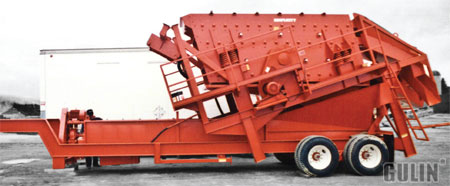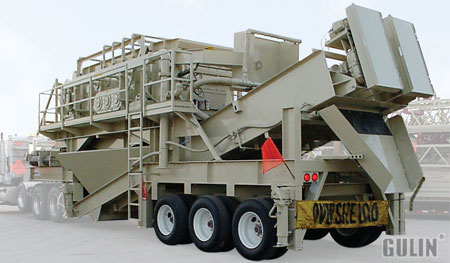Gulin® is a professional manufacturer of closed circuit gold wash plant. And we supply all types crushing machines and design gold ore production line based on the requirements of customers. Our gold ore crushing machines have exported to South Africa, USA, Australia, Russia, Canada, Egypt, UZ, Nubian, Peru, Indonesia, Brazil, Papua New Guinea, Ghana, Mexico, Philippines, Zimbabwe, Mali, Kyrgyzstan, Argentina, Guinea, KZ, etc.
Closed Circuit Gold Wash Plant
The leached solids are dewatered continuously, washed if necessary, then transferred to the tailing storage or treatment facility. Dewatering is carried out using a combination of cones, screens and cyclones to take full advantage of the coarse nature of the concentrate. This minimises costs in this potentially very costly process step. Floc is added if required to collect slimes.
Dry gold washer plant
Various gasoline motor-driven dry concentrating units are available on the market which utilize static electricity and high-frequency vibration to help with gold recovery. Most commonly, there is a high-powered air-fan which pumps air through a discharge hose into the concentrator’s recovery system. The air currents which pass through the recovery system are adjustable so that the proper amount of flow of lighter materials through the recovery system can be obtained-similar to a sluice box in wet-processing. The purpose of the steady airflow is to “float off” the lighter materials through the box. Heavier materials like gold will have too much weight to be swept through the recovery system by the flow of air.
Some motorized dry concentrators also use a high-frequency vibrating device to keep the entire recovery system in continuous vibration while in operation. The way to get gold particles to settle quickly down through other lighter materials is to put the materials into a state of suspension. The vibrating device on this concentrator helps fine particles of gold work their way down through lighter materials that are being suspended by air-flows.
benefits of gold washing plant
• low capital expenditure
• low running cost
• high efficiency
• robust modular design
• quick assembly easy to move
• extensive product range
• low power use
Dry-washing and clay-like materials
Material to be processed must be thoroughly dry to get the best results out of any dry-washing plant. Sometimes you will run into moist clays when out in the dry regions-just like you do in the wet streambed areas. It is also possible to find a pay-layer associated with the clay. Clays make dry-washing procedure more difficult, because they must be thoroughly dried out and broken up before being processed effectively by dry methods.
Sometimes this means the material needs to be set out in the sun to dry for a full day or more before anything further can be done with it. Sometimes it is necessary to dig clay a couple of days ahead of the processing stage. You can alternate spending a day digging and laying out material to dry, and then a day processing dried material. Sometimes, the dried clay can harden into clumps, which then must be broken down into dust and sand before you can recover the gold out of it. When necessary, all of these requirements require more time and energy. But if a good pay-streak is involved, you will find yourself doing whatever is necessary to recover the gold out of it.



